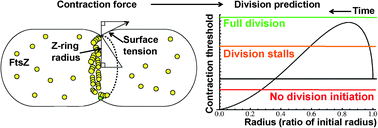A model of membrane contraction predicting initiation and completion of bacterial cell division
Abstract
Bacterial cell division involves a complex and dynamic sequence of events whereby

* Corresponding authors
a
Molecular Organisation and Assembly in Cells Doctoral Training Centre, Senate House, University of Warwick, Coventry, UK
E-mail:
C.E.Dow@warwick.ac.uk
b Department of Chemistry and Warwick Centre for Analytical Science, University of Warwick, Coventry, UK
c School of Life Sciences, University of Warwick, Coventry, UK
d Mathematics Institute, University of Warwick, Coventry, UK
Bacterial cell division involves a complex and dynamic sequence of events whereby

 Please wait while we load your content...
Something went wrong. Try again?
Please wait while we load your content...
Something went wrong. Try again?
 Fetching data from CrossRef.
Fetching data from CrossRef.
This may take some time to load.
Loading related content
